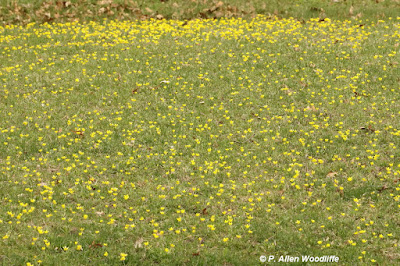New life is increasing at a steady pace these days. Although there hasn't been a lot of April shower activity, the sporadic bit that we have had, as well as the greater abundance of snow these past few months, has allowed the usual emergence of early spring flowers.
I do most of my spring wildflower exploration at Rondeau, which has some of the greatest biodiversity of anywhere in Ontario. However since it is a peninsula sticking out into the cold waters of Lake Erie, the usual prevailing winds coming off the water affects the temperature at Rondeau making the emergence at least a week or two behind inland areas.
Certainly one of the earliest and showiest wildflower is Bloodroot, a native woodland species that I always consider to be a harbinger of spring.
At about the same time, is Colt'sfoot. not a native species, but somewhat showy itself. It usually is seen at the edge of woodlands.As the temperatures increase a bit, and the days get longer, there is a progression of colour. In open, grassy oak woodland, Early Buttercup can dominate. This first photo shows the abundance of this species in a section of the picnic area at the north end of Rondeau.
In the more woodland areas, Dutchman's Breeches are nice to find.Cut-leaved Toothwort emergence can vary a little, as this one shows that it is just about to open, but not quite. This species can be quite abundant on the rich, forest floor.Hepatica, shown next, come in two types: Sharp-lobed and Round-lobed types, based primarily on the shape of their leaves. As the leaves of individuals are not always visible, it is sometimes hard to determine which is which. But they are attractive, with the flowers sometimes in a rich purplish colour.......but more often, as almost white.Flowers also occur on woody plants, and one of the most dominant species at Rondeau is Spicebush. Due to the more open forest canopy of Rondeau in recent years, as a result of the decline of Ash trees from the Emerald Ash Borer, and the slower decline of American Beech trees due to Beech Leaf Disease, the growth response of Spicebush is quite amazing. When the majority of them are all in flower, it can create a distinctive yellow glow to the forest understorey.In open, dry sandy areas, Lyreleaf Rockcress is fairly abundant.
 |
| Narrow-headed Marsh Fly |
Flowers aren't always large and showy, and even things like members of the sedge family have flowers of some type. This next one is an Oak Sedge, showing a close-up first, and then a small clump which is fairly common along open forest edges. This one was photographed along the north end of Harrison Trail.
Violets can be fairly common. This is Smooth Yellow Violet, which lacks the hairiness on the stems that are more typical of Downy Yellow Violet.And of course one of the highlights of the spring wildflower season is the appearance of Ontario's provincial wildflower, the White Trillium. They are just starting to show up at Rondeau, although I expect they are much more common in many inland woodlands.
These are just a foreshadowing of a much greater variety of wildflowers to come in May, as long as there is adequate April showers! We will certainly see in the next few weeks!
If you would like to subscribe, or unsubscribe, to Nature Nuggets, send an email to: prairietramper@gmail.com




















An abundance of new life. Wonderful. It mimics and is a reminder of the Easter story.
ReplyDeleteThank-you Paula.....it is indeed a reminder.
Delete